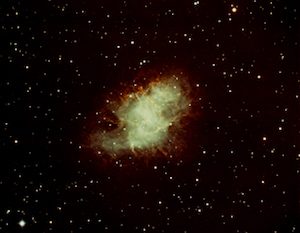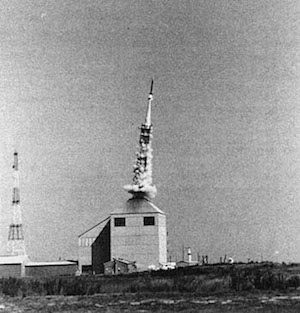Supernovae Leave Behind Cosmic X-ray Generators
Two years after discovering that the Universe is awash in X-rays, astronomers are starting to pinpoint discrete sources with greater accuracy – and none of them resembles your doctor's X-ray machine.

Image credit: Carnegie Institution
Crab Nebula
One X-ray source is called the Crab nebula and is the remains of a star that exploded nearly 900 years ago. Those remains are often called a supernova remnant. The second source, called Ophiuchus XR-1, appears to lie in the direction of another past supernova. In fact, if you drew a map of all of the X-ray sources and compared it to a map of all of the supernova remnants, the two would look similar. Astronomers aren't sure what is causing X-ray radiation from these sources far, far away from the Sun. If Ophiuchus really does come from a supernova remnant, then astronomers can compare the two sources to peel back some of the mystique.
The task of identifying these two X-ray sources was not easy. X-rays cannot penetrate Earth's atmosphere so the trick was to get enough time in space, onboard rockets, to allow X-ray astronomical instruments to find the distant sources. Because of this property of X-rays, this new field of X-ray astronomy is rather difficult and expensive; each rocket launch only allows five minutes of time to observe. However, because Earth's atmosphere blocks X-rays, life has been protected from occasional X-ray flares found here close to the Sun.

Image credit: NASA
An Aerobee rocket launches from Wallops Island, Virginia. NASA rocket is similar to those used in recent discoveries of cosmic X-ray sources such as Scorpius X-1 and, more recently, the Crab nebula and Ophiuchus XR-1.
The Crab nebula and Ophiuchus XR-1 discoveries are the culmination of about three years of rocket flights in search of X-ray sources other than our Sun. Our Sun doesn't put out a lot of X-rays, but it's the closest such source in the sky. The first rocket launch in 1962 was designed to use its five minutes in space to observe the Moon. Riccardo Giacconi and his team at the American Science and Engineering group expected to discover Moon minerals fluorescing in X-rays after being smacked and excited by heavy atomic particles (solar wind) flung out by the Sun. They were wrong.
What they found instead was far more amazing and unexpected: X-rays coming from every direction and a particularly intense X-ray source from the direction of the con-stellation Scorpius. They named this area Sco X-1. Unlike the Crab nebula, Sco X-1 still has not been tracked to any known object. For now, it's a space mystery.
X-ray astronomers are hoping that someday their jobs will get a little easier by placing one of their instruments in a stable orbit so they can spend more time looking at the X-ray universe. Until that day, they will be limited to observing X-rays during those five floating minutes in space with their instruments on a rocket. •



